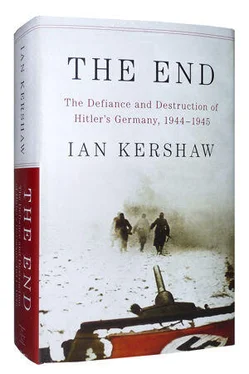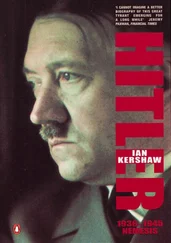54. IWM, EDS, F.2, AL2682, Bormann to Kaltenbrunner, 4.4.45.
55. StAA, Gauleitung Schwaben, 1/28, fo. 328839, Schulz to Gauleitung Schwaben, 8.4.45, with handwritten note by Wahl at foot.
56. StAA, Kreisleitung Günzburg 1/43, fos. 00991, 00999, Kreisleiter to all Bürgermeister, Ortsgruppenleiter and Ortsamsleiter der NSV, 18.4.45, and (undated) order of Kreisleiter.
57. TBJG , II/15, pp. 612–13 (28.3.45), a comment also related to Hitler’s orders for the destruction of industry.
58. TBJG , II/15, p. 684 (8.4.45). The difficulties of feeding refugees sent to the Allgäu in the Alpine region of southern Bavaria led to demands for the influx to be halted.—StAA, Gauleitung Schwaben, 1/29, fos. 328886–7, report of Landesbauernführer Pg. Deininger on ‘Ernährungslage’, 14.4.45.
59. IfZ, Fa-91/5, fo. 1120d, Lagemitteilung Gauleiter Eigruber, 9.4.45; BAB, NS6/277, fo. 101–101 v, Dienstleiter Hund, Parteikanzlei München, to GL Wächtler, Bayreuth, 10.4.45; fo. 31, Hund to Pg. Zander, Dienststelle Berlin, 10.4.45; fos. 8–9, Lagebericht of Gauleitung Salzburg, 10.4.45, Fernschreiben, Hund to Bormann, 14.4.45; fo. 11, Aktenvermerk, 17.4.45. Gauleiter Hugo Jury in Gau Niederdonau also sought advice from Bormann (fo. 92) about where to send 30,000 refugees from Silesia, currently in the District Iglau in the Protectorate who had to be brought into the Reich. He said he would do his utmost to accommodate those who came from his Gau, but was evidently unwilling to receive those from outside. Gauleiter Eigruber later recalled the chaotic conditions as tens of thousands of Hungarian refugees, and 15,000 Jews from the Lower Danube and Styria who were dispatched to Mauthausen concentration camp, were sent to his domain, which had no food for them.—IWM, FO645/156, interrogation of August Eigruber, 3.11.45.
60. BAB, NS6/277, fo. 130, Funkspruch Walkenhorsts an Reichsleiter Bormann, 5.4.45 (also IfZ, Fa-91/5, fo. 1106). Also: fos. 110–12, Vermerk for Bormann from Pg. Zander, 5.4.45; fo. 113, Walkenhorst, telefonische Vorlage an den Reichsleiter, 5.4.45; fo. 15, Aktenvermerk referring to the inability of Gauleiter Siegfried Uiberreither of Styria to reach Berlin with an urgent message for General Jodl; fo. 4, Pg. Walkenhorst zur telefonischen Durchgabe nach Berlin (on varied communications difficulties and attempts to overcome them), 12.4.45.
61. TBJG , II/15, p. 677 (4.4.45).
62. 1945: Das Jahr der endgültigen Niederlage der faschistischen Wehrmacht , pp. 346–8.
63. BAB, NS6/756, fos. 7–9, Vermerk für Chef der Sicherheitspolizei und des SD, Parteifeindliche Einstellung der Wiener Arbeiterbevölkerung nach den Luftangriffen, 10.3.45. See also fos. 14–15 for a report dated the previous day by Gauleiter Ernst-Wilhelm Bohle, head of the Nazi Party’s Auslandsorganisation, on his impressions of Hungarian women and other foreigners behaving as if Vienna were a holiday resort, and fos. 12–13 for an account sent to Walkenhorst on 2 April of the poor situation in the city and lack of leadership of the Wehrmacht and of the Party. See also TBJG , II/15, pp. 687, 693 (8–9.4.45). A brief indication of the collapse in Vienna as seen by the regime is provided by Karl Stadler, Österreich 1938–1945 im Spiegel der NS-Akten , Vienna, 1966, pp. 401–4. See also, for the rapidly worsening conditions and mounting problems for the Nazi leadership in Vienna in the weeks before the city fell, Rauchensteiner, pp. 154–7, 163–6.
64. TBJG , II/15, pp. 666, 680 (2.4.45, 4.4.45).
65. TBJG , II/15, pp. 683, 687, 693 (8.4.45, 9.4.45).
66. BAB, NS6/353, fo. 103, RS 211/45, ‘Einsatzpflicht der Politischen Leiter’, 15.4.45. A month earlier, referring to previous similar directives, Bormann (fo. 80, Rundschreiben 140/45, ‘Persönlicher Einsatz der Hoheitsträger’, 17.3.45) had exhorted high-standing representatives of the Party to cooperate with troops in assisting the population in the fighting zone and to set an example of fighting morale.
67. TBJG , II/15, p. 659 (1.4.45).
68. TBJG , II/15, p. 672 (4.4.45).
69. For example, despite their exhortations, accompanied by threats, to hold out, most of the Kreisleiter in Württemberg fled as Allied troops approached.—Christine Arbogast, Herrschaftsinstanzen der württembergischen NSDAP: Funktion, Sozialprofil und Lebenswege einer regionalen Elite 1920–1960 , Munich, 1998, p. 260. One Kreisleiter from the Black Forest, who turned up in Munich to offer his services to the Party Chancellery, was immediately ordered to return to serve with the Volkssturm and warned that his arrival in an official car could be seen as nothing other than flight.—BAB, NS6/277, fo. 24, Aktenvermerk, 20.4.45.
70. IfZ, ZS 597, fo. 113 (1950); TBJG , II/15, p. 672 (4.4.45); Karl Höffkes, Hitlers politische Generale: Die Gauleiter des Dritten Reiches. Ein biographisches Nachschlagewerk , Tübingen, 1986, pp. 112–13. The Security Police had disbanded their office on 7 March, and, destroying records, fled in civilian clothes with false identity cards.—NAL, KV3/188, interrogation of Ostubf. Karl Hans Paul Hennicke, head of SD-Abschnitt Köln-Aachen, 11.4.45.
71. Ralf Blank, ‘Albert Hoffmann als Reichsverteidigungskommissar im Gau Westfalen-Süd, 1943–1945: Eine biografische Skizze’, in Wolf Gruner and Armin Nolzen (eds.), ‘Bürokratien’: Initiative und Effizienz. Beiträge zur Geschichte des Nationalsozialismus , vol. 17, Berlin, 2001, pp. 201–2.
72. Ralf Meindl, Ostpreußens Gauleiter: Erich Koch—eine politische Biographie , Osnabrück, 2007, p. 452.
73. Wilfred von Oven, Finale Furioso: Mit Goebbels bis zum Ende , Tübingen, 1974, pp. 635–7 (12.4.45); Meindl, p. 455; Alastair Noble, Nazi Rule and the Soviet Offensive in Eastern Germany, 1944–1945: The Darkest Hour , Brighton and Portland, Ore., 2009, p. 240; Isabel Denny, The Fall of Hitler’s Fortress City: The Battle for Königsberg, 1945 , London, 2007, p. 230; Speer, p. 498. Whether, as Oven claimed (p. 636), Koch had influenced Hitler in condemning General Lasch, commander of Königsberg, to death in absentia for his ‘cowardly’ capitulation is doubted by Meindl, p. 454.
74. Höffkes, p. 24.
75. BAB, NS6/277, fos. 76–8 (17.4.45). Printed in Karl Kunze, Kriegsende in Franken und der Kampf um Nürnberg im April 1945 , Nuremberg, 1995, pp. 217–19.
76. Kunze, pp. 243–4, 265, 283–5; Höffkes, p. 156. The local attempts of courageous individuals and groups of citizens in Central Franconia to prevent the mania of Nazi fanatics from bringing about the destruction of their towns can be seen in Hans Woller, Gesellschaft und Politik in der amerikanischen Besatzungszone: Die Region Ansbach und Fürth , Munich, 1986, pp. 46–57.
77. Ernst Hornig, Breslau 1945: Erlebnisse in der eingeschlossenen Stadt , Munich, 1975, pp. 129–31; Hans von Ahlfen and Hermann Niehoff, So kämpfte Breslau: Verteidigung und Untergang von Schlesiens Hauptstadt , Munich, 1959, p. 83; Friedrich Grieger, Wie Breslau fiel …, Metzingen, 1948, pp. 23–4; Joachim Konrad, ‘Das Ende von Breslau’, Vf Z , 4 (1956), p. 388.
78. TBJG , II/15, pp. 692–3 (9.4.45). Höffkes, p. 122, dates the award to 12 April, though Goebbels refers to the granting of the honour already on 9 April.
79. BAB, R3/1625, fo. 2, Speer to Hanke, 14.4.45.
80. After his flight from Breslau, Hanke was captured on 6 May by Czech partisans, though not recognized, and was killed early the following month while trying to escape.—Höffkes, pp. 122–3; Michael D. Miller and Andreas Schulz (eds.), Gauleiter: The Regional Leaders of the Nazi Party and their Deputies , CD-ROM, n.d. ( c . 2004), vol. 1.
Читать дальше












